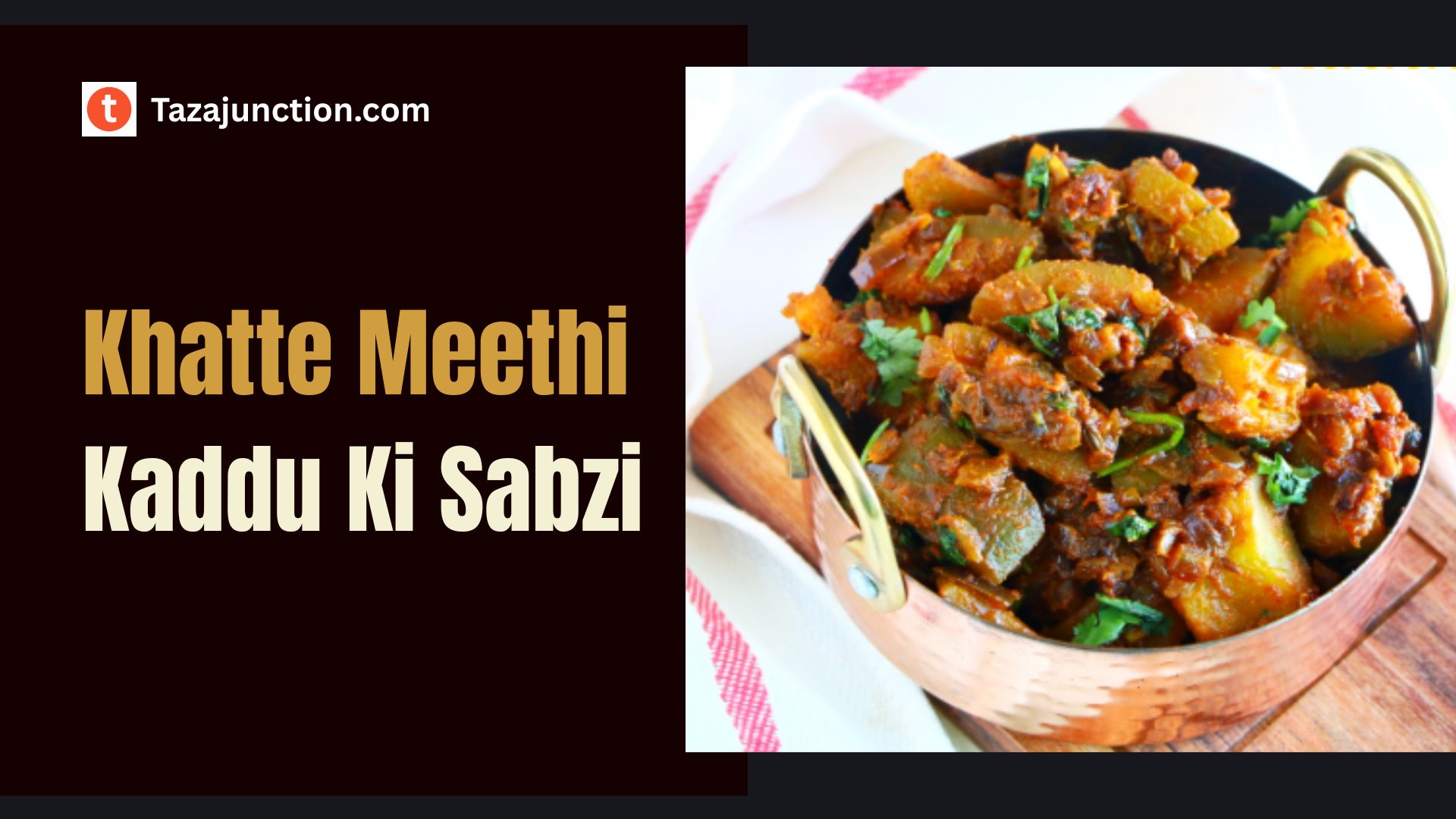Khatte Meethi Kaddu Ki Sabzi, or sweet and sour pumpkin curry, is a comforting, rustic dish that holds a cherished spot in North Indian households.
Made with humble ingredients, this traditional recipe transforms the often-underappreciated pumpkin into a sweet, tangy, and spicy delicacy that pairs beautifully with puris, parathas, or even plain rice.
Though simple in preparation, khatte meethi kaddu is a dish rich in flavors, cultural significance, and nostalgia—often prepared during festive occasions, fasting days, or as part of temple offerings.
If you are fond of technology and business news, then you read our latest post on Tazajunction.com
Table of Contents
🧡 Why Pumpkin? A Staple in North Indian Kitchens
In North India, pumpkin—known as kaddu or sitaphal—is widely consumed for its affordability, nutrition, and adaptability. The vegetable is especially popular in Uttar Pradesh, Rajasthan, Punjab, and Delhi, where it forms part of everyday meals, especially in vegetarian households.
Khatte Meethi Kaddu stands out among pumpkin recipes because it balances contrasting flavors: the earthy sweetness of pumpkin, the tang of amchur (dry mango powder) or tamarind, and the kick of Indian spices.
🍽️ Cultural Significance
Khatte meethi kaddu is more than just a vegetable side dish—it’s deeply rooted in Indian food culture and religious practices:
- Often served during Navratri and other fasting days
- Paired with poori as a traditional sattvic meal (free from onion and garlic)
- Commonly included in festive thalis during Diwali, Holi, or religious ceremonies
- Served as prasad (sacred food) in temples and households
Despite its simplicity, it carries emotional weight—reminding many of home-cooked meals prepared by mothers and grandmothers.
🧾 Ingredients for Khatte Meethi Kaddu Ki Sabzi
One of the best things about khatte meethi kaddu ki sabzi is its accessibility. It requires no exotic ingredients—everything is usually available in a typical Indian pantry.
Main Ingredients:
- 500g pumpkin (preferably red pumpkin/kaddu)
- 2 tbsp oil or ghee
- 1/2 tsp mustard seeds
- 1/2 tsp cumin seeds
- A pinch of asafoetida (hing)
- 1/2 tsp turmeric powder
- 1 tsp red chili powder (adjust to taste)
- 1 tsp coriander powder
- Salt to taste
- 1–2 tsp jaggery or sugar
- 1–2 tsp amchur powder (dry mango powder) or lemon juice
- Fresh coriander for garnish
🥘 Step-by-Step Recipe

Step 1: Prepare the Pumpkin
- Wash, peel, and chop the pumpkin into medium-sized cubes.
- Remove seeds and stringy pulp.
Step 2: Tempering the Spices
- Heat oil or ghee in a thick-bottomed kadhai or pan.
- Add mustard seeds. Once they splutter, add cumin seeds and hing.
- Lower the heat and add turmeric, red chili, and coriander powder.
- Stir for a few seconds to release aroma, being careful not to burn the spices.
Step 3: Cooking the Pumpkin
- Add chopped pumpkin and mix well so the spices coat every piece.
- Sprinkle salt and 1–2 tablespoons of water.
- Cover and cook on medium-low flame for 10–12 minutes, stirring occasionally.
- Once the pumpkin is soft but retains shape, proceed to the next step.
Step 4: Add Sweet and Sour Flavors
- Stir in jaggery or sugar. Let it melt and coat the pumpkin.
- Add amchur powder or lemon juice for tanginess.
- Cook for another 2–3 minutes until the flavors blend and the dish slightly thickens.
Step 5: Garnish and Serve
- Garnish with chopped fresh coriander.
- Serve hot with poori, paratha, or rice.
👨🍳 Chef’s Tips for the Perfect Kaddu Sabzi
- Don’t overcook the pumpkin—it should be soft but not mushy.
- Use jaggery for an earthy sweetness and better texture.
- Amchur gives a sharp tang, but tamarind pulp or lemon juice can be used as substitutes.
- For a dry sabzi, cook without water and let the pumpkin caramelize slightly.
- Prefer mustard oil or desi ghee for an authentic North Indian flavor.
🍛 Serving Suggestions
Khatte Meethi Kaddu Ki Sabzi is traditionally enjoyed with:
- Pooris – Especially during festive meals like Ashtami Prasad
- Ajwain Paratha – The earthy flavor of ajwain complements the sweetness
- Steamed Rice – Pair with dal for a complete meal
- Kuttu or Singhara Roti – During Navratri or fasting days
It’s often served alongside other sattvic dishes like kale chane, aloo sabzi, kheer, and raita.
🧪 Nutritional Value
Pumpkin is a nutritional powerhouse:
| Nutrient | Per 100g (cooked) |
|---|---|
| Calories | 26 kcal |
| Carbohydrates | 6.5 g |
| Fiber | 0.5 g |
| Vitamin A | 148% of RDA |
| Vitamin C | 9% of RDA |
| Potassium | 340 mg |
The sabzi is:
- Low in calories
- Rich in beta-carotene
- Easily digestible
- Naturally gluten-free
It’s ideal for children, elderly people, and anyone looking for light, nutritious meals.
🧂 Variations Across Regions
Though the base concept of sweet and sour kaddu remains, variations exist across North India:
- Rajasthani Style: Often uses more spices and a bit of garam masala
- Bihari Version: Includes panch phoron (five-spice mix)
- Uttar Pradesh: Tends to be simpler, often prepared without onions or garlic
- Punjabi Style: May include kasuri methi or green chilies for a spicier twist
These small changes give each version its own regional identity while retaining the dish’s essence.
📖 Vrat (Fasting) Version
During Navratri and Ekadashi, the Khatte Meethi Kaddu Ki Sabzi is made without regular salt, using sendha namak (rock salt) instead. It’s cooked in ghee, and paired with kuttu ki poori or sabudana khichdi.
This version avoids onion, garlic, and certain spices, aligning with traditional fasting rules in Hindu culture.
🕉️ Kaddu in Ayurveda
According to Ayurveda, pumpkin is:
- Cooling in nature (Sheetal)
- Balances Pitta and Vata dosha
- Promotes digestion and nourishes the body tissues
When combined with jaggery and spices, it becomes tridoshic—beneficial for all body types. The sweet and sour balance also supports mental and emotional harmony.
❤️ Nostalgia on a Plate
Ask any North Indian about khatte meethi kaddu, and chances are it will remind them of:
- Festive meals at home
- Weekend brunch with poori and sabzi
- The aroma of ghee and spices from their mother’s kitchen
- Temple food or prasad served during pujas
It’s one of those dishes that transcends taste—connecting food with memory, family, and tradition.
✅ Conclusion
Khatte Meethi Kaddu Ki Sabzi is a timeless dish that showcases the brilliance of Indian cooking—how simple ingredients can be elevated into something soulful, satisfying, and culturally rich.
Whether made for a festive celebration or a comforting weekday meal, this sweet and sour pumpkin dish is a heartwarming reminder of the warmth of Indian kitchens.
So next time you spot a pumpkin in your vegetable basket, don’t overlook it. Give this classic North Indian dish a try and enjoy the beautiful contrast of sweetness, tanginess, and spice in every bite.

